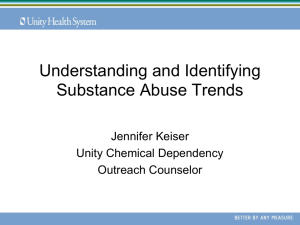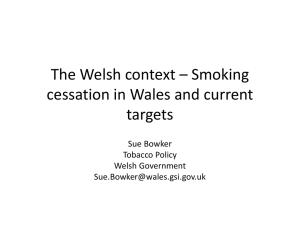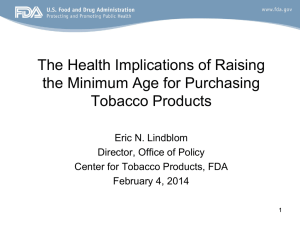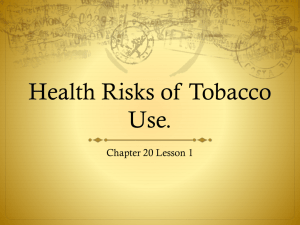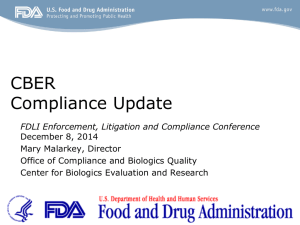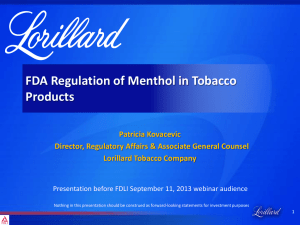Tobacco Regulation Since 1964
advertisement
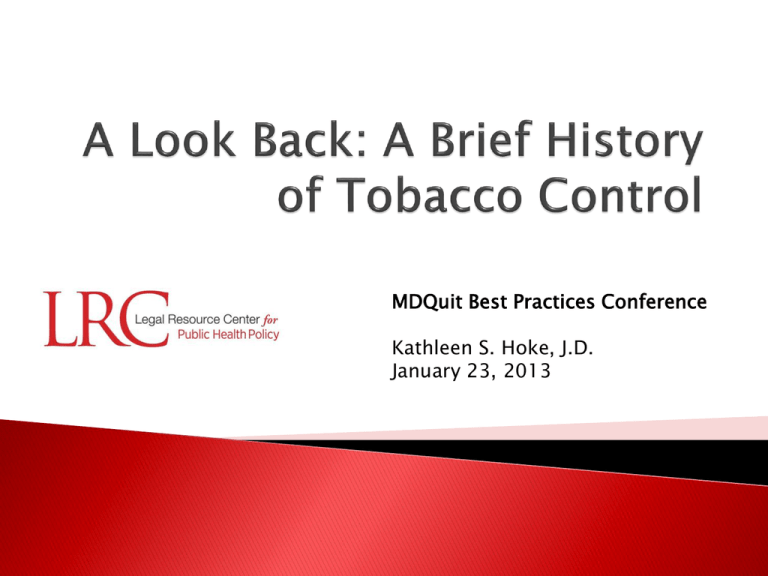
MDQuit Best Practices Conference Kathleen S. Hoke, J.D. January 23, 2013 Pre-1996 No regulation. 1996 FDA Commissioner, David Kessler, issues regulations imposing sales and advertising restrictions on cigarettes and smokeless tobacco. 2000 Supreme Court decides FDA v. Brown and Williamson, holding that the agency lacked power to regulate tobacco products. 1996 regulations invalidated. Prior to FDA intervention, Congress and the states oversaw tobacco products. Federal Cigarette Labeling and Advertising Act (1965) ◦ Warning Labels mandatory on all cigarette packs Caution: Cigarette Smoking May be Hazardous to Your Health Note: Other health warnings prohibited ◦ Prohibited warning labels on cigarette advertisements (for three years) ◦ State and local governments preempted from regulating the advertising or marketing of tobacco products Public Health Cigarette Smoking Act (1969) Comprehensive Smoking Education Act (1984) ◦ Required package warning label – Warning: The Surgeon General Has Determined that Cigarette Smoking is Dangerous to Your Health (other warnings prohibited) ◦ Prohibited cigarette advertising on TV and Radio ◦ Prevents states or localities from regulating or prohibiting cigarette advertising or promotion for health-related reasons ◦ Requires four rotating health warning labels: Smoking causes lung cancer, heart disease and may complicate pregnancy Quitting smoking now greatly reduces serious risks to your health Smoking by pregnant women may result in fetal injury, premature birth, and low birth weight Cigarette smoke contains carbon monoxide Comprehensive Smokeless Tobacco Health Education Act (1986) ◦ Prohibits smokeless advertising on television and radio ◦ Requires warning labels on smokeless packages and advertisements ◦ Note: First SGR on smokeless tobacco was also released in 1986 FDA claimed authority over cigarettes and smokeless tobacco because: ◦ Nicotine is a drug within FDCA; AND ◦ Cigarettes and smokeless tobacco are drug delivery devices FDA promulgated regulations restricting cigarette/smokeless tobacco advertising, labeling and youth access Summary of Regulations: ◦ ◦ ◦ ◦ Must be 18 w/valid license to purchase Cigarettes must be sold in packs of at least 20 No free samples No self-service displays or vending machines Group of tobacco advertisers, manufacturers and retailers bring suit (in N.C. district court) challenging FDA authority to regulate tobacco products as customarily marketed. Also, claim advertising restrictions violate 1st Amendment District Court – found FDA had authority to regulate tobacco products, but advertising restrictions violated 1st Amendment 4th Circuit Court of Appeals – Reversed decision stating Congress did not grant FDA jurisdiction to regulate tobacco products “Viewing the FDCA as a whole, it is evident that one of the Act’s core objectives is to ensure that any product regulated by the FDA is ‘safe’ and ‘effective’ for its intended use.” “[T]he Act generally requires the FDA to prevent the marketing of any drug or device where the ‘potential for inflicting death or physical injury is not offset by the possibility of therapeutic benefit.’” Court Reasoning: If the FDA had authority to regulate tobacco products, the agency would have to ban their marketing and sale because they are not safe and the harm of use vastly outweighs any therapeutic benefit (because there is none). Congress passed several laws relating to tobacco products (i.e. FCLAA—warning labels), and therefore did not intend for tobacco products to be banned. Congress considered and rejected several bills granting FDA authority over tobacco products Prior to 1995, FDA repeatedly stated it did not have jurisdiction to regulate tobacco products 2001: Kennedy-DeWine Bill introduced in Congress; failed to get out of committee 2004: Kennedy-DeWine Bill PASSES SENATE 2007: Kennedy-DeWine Bill PASSES key House Committee 2008: House Bill passes but too late for Senate to pass TCA grants FDA authority over tobacco and reimposes 1996 regulations ◦ ◦ ◦ ◦ Cigarettes must be sold in packs of at least 20 Must be 18 w/valid ID No free samples No self-service displays ) Additional Restrictions: ◦ Prohibits sale of flavored cigarettes ◦ Eliminates use of terms Light, Mild, Low Tar, etc. ◦ Allows for state and local regulation in most areas, reserving only certain products standards/new product approval/reduced harm product regulation exclusively for FDA. (Note: Reverses comprehensive preemption clause since 1965)



